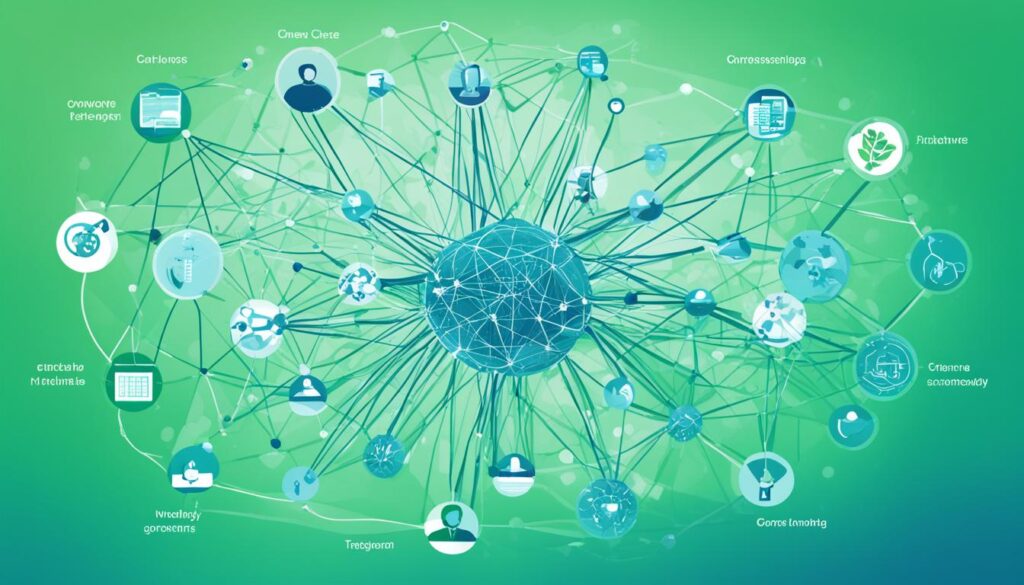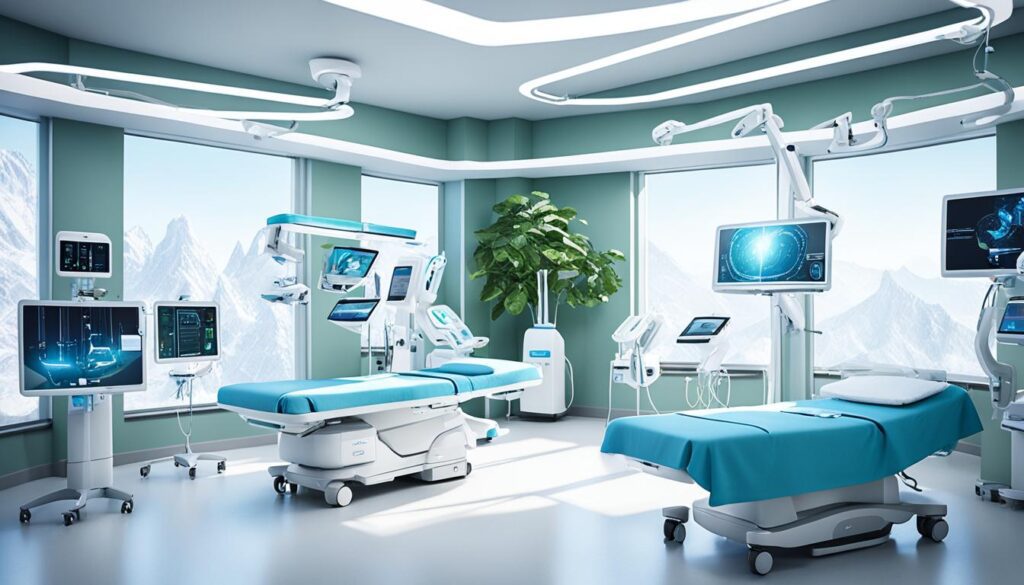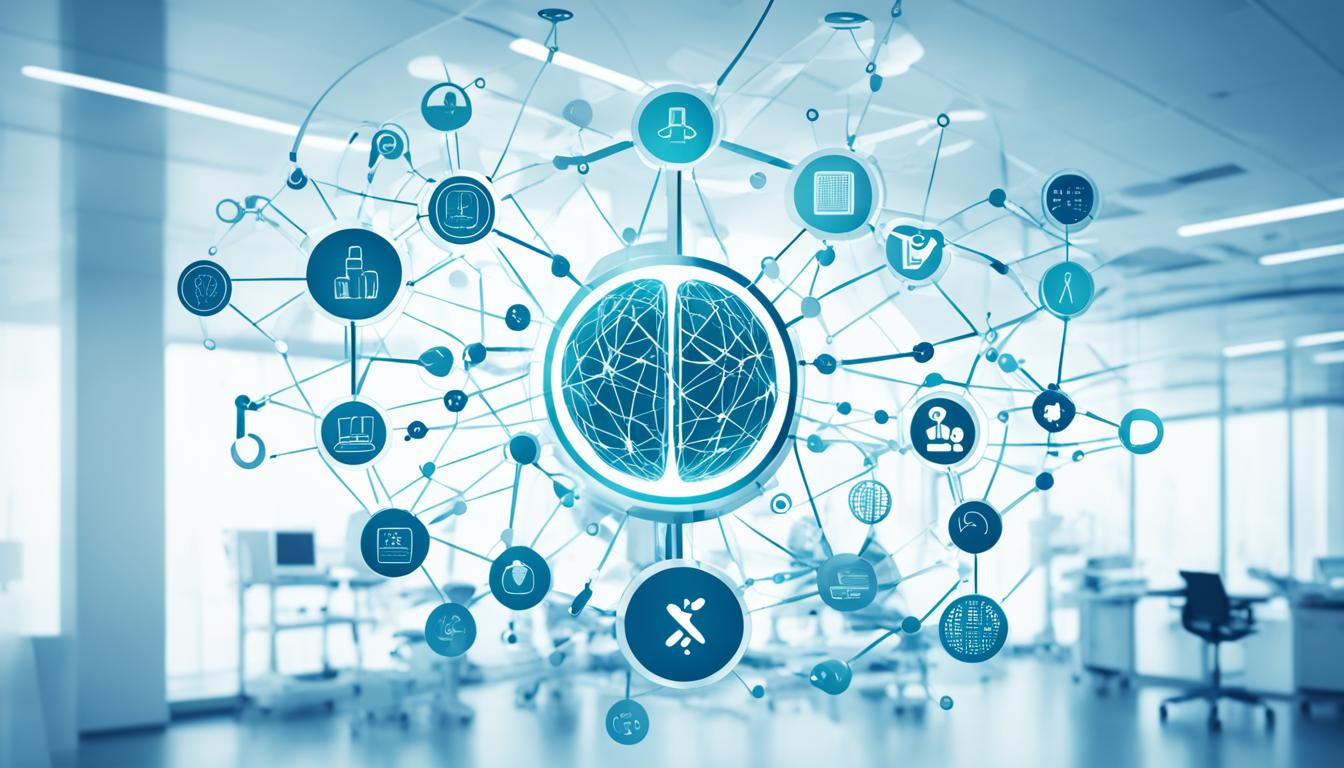Ever wondered how technology changes healthcare? It makes handling patient data smooth and simplifies clinical steps. Health Information Technology (HIT) is the key player in this transformation.
HIT includes various tools like electronic health records and telemedicine software. It’s also about making sure different systems can share data. All this boosts patient care and how health professionals use information.
Ready to learn more about how Health IT affects patient outcomes and data use? Let’s start exploring the amazing world of Health Information Technology. We’ll discover how it’s changing healthcare.
Key Takeaways:
- Health Information Technology (HIT) is changing the healthcare world by improving patient data and clinical processes.
- HIT uses tools such as electronic health records and telemedicine. It ensures different tech can work together for better care.
- As HIT evolves, it enhances patient care and the way data is handled. It’s helping to shape the future of healthcare.
The Emergence of Health Information Technology
Health Information Technology (HIT) is changing healthcare as we know it. This change is fueled by new digital tools and the growing use of electronic health records (EHRs). It’s making patient care better, workflows smoother, and conversations between medical teams clearer.
Health Information Technology uses digital tools to manage data better. It improves care for patients and helps in making healthcare choices. These tools include EHRs and telemedicine, which make sharing secure and doctors working together more straightforward.
Technology has made a big difference in how healthcare is given out. EHRs give doctors full patient histories, leading to smarter choices and custom treatment plans. Telemedicine offers checkups and care from far away, making good healthcare more available, especially in areas with fewer services. All this tech is pulling everyone together to care for patients in the best way possible.
Health technology keeps getting better, and it’s looking towards the future. New tools like AI, machine learning, and blockchain are not just buzzwords. They carry the promise of making patient care safer and more effective than ever before.
Electronic Health Records: A Pillar of Modern Medical Data Management
Electronic Health Records (EHRs) are key in managing medical data today. They turn patient details into digital form, like history and lab results. EHRs make it easy to get to data, making health care better and decisions wiser. The switch from paper to digital records has changed how patient info is stored and shared.
The Digitalization of Patient Information
Digitalizing patient info is a major part of EHRs. It lets health workers quickly find and update data with no paper. This quick and easy access can mean better and faster care. It reduces the chance of making errors or losing important documents too.
Benefits of EHRs to Healthcare Providers and Patients
EHRs help both doctors and patients a lot. Health providers can now easily share info that helps patients get better, safer care. EHRs come with alerts and reminders to avoid mistakes and have drugs that work well together.
Patients like EHRs because they can see and manage their own health info. They can check their records and plan treatments online. This means they can be more involved in their own care. EHRs also make it simpler to see a doctor online when needed, saving time and effort. Plus, they help doctors keep up with check-ups and stay healthy more easily.
Privacy and Security Challenges in Electronic Health Records
However, EHRs also face privacy and security issues. Keeping patient data safe from hackers and other risks is critical. It’s important to make sure patient info stays private while using electronic health records.
Healthcare firms must work hard to keep EHRs safe. They can use things like encryption to lock out bad actors. Regular checks and teaching staff how to keep info safe also help a lot. With the right steps, EHRs can be used safely and keep patient info private.
Electronic health records are changing how health data is handled, making things better for doctors and patients. They make info easy to work with and share, improving health care. Yet, making sure this data stays private and secure is a top challenge. This issue must be dealt with seriously in the EHR era to protect patient information.
Telemedicine Software: Bridging the Gap Between Patients and Providers
Telemedicine software is a crucial tool for connecting patients and doctors. It’s especially helpful in remote areas or during health crises. Thanks to technology, we now have virtual checkups, remote patient monitoring, and secure messages. This means patients can get medical help no matter where they are.
The COVID-19 pandemic has shown us how vital telemedicine is. It allows for medical care without in-person visits, lowering the risk of spreading diseases. With telemedicine, patients can see doctors from home, which is safe and comforting. This technology has truly been a lifeline for many.
Telemedicine means doctors can see patients online. This is especially good news for those far from medical centers. With just a video call, they can get the advice they need. It saves on travel time and cuts down waiting for appointments.
Another big plus of telemedicine is remote monitoring. Doctors can keep an eye on patients’ health from far away. This helps with chronic diseases and keeps treatments on track. With telemedicine, patients feel more in control of their own health.
Safe and private communication is key in healthcare. Telemedicine ensures messages between patients and doctors aren’t seen by others. This keeps patient information secure and conversations confidential.
More and more people are using telemedicine for better healthcare access. It’s a lifeline for those who can’t easily get to a doctor. This technology makes healthcare come to the patient, no matter the distance. It’s breaking down obstacles to good healthcare for everyone.
Interoperability in Healthcare: Connecting Disparate Systems

Interoperability boosts patient outcomes and saves resources in healthcare. It means sharing patient data smoothly among different tech systems and devices. This way, healthcare groups can better coordinate care, keep treatment consistent, and easily share information.
The Importance of Data Sharing in Healthcare
Data sharing is vital for better healthcare. It allows doctors to see a patient’s full health story for detailed diagnoses and personalized treatments. Sharing data means healthcare groups can work together better, cut down mistakes, and improve safety.
It also helps with research and managing public health. This lets doctors find health trends, take steps to prevent sickness, and rely on facts to make decisions.
Standards and Frameworks Driving Interoperability
Interoperability in healthcare needs set standards and frameworks. These ensure that health data can be shared easily. Standards like HL7, FHIR, and DICOM help different systems talk the same language. This is key for breaking down tech barriers to data exchange.
Technologies like FHIR help build apps and APIs that work well across healthcare systems. FHIR uses up-to-date web tech and follows the best approaches. This means health info can be shared safely. By adopting these tools, healthcare groups can improve care, and foster new ideas in medicine.
| Benefits of Interoperability in Healthcare | Challenges in Achieving Interoperability |
|---|---|
|
|
Healthcare IT: A Key Driver in Patient-Centered Care
Healthcare IT is making big waves in patient-centered care. It’s all about making the patient’s needs a priority in healthcare. Thanks to technology, care plans can be made just for you. You get to be part of important decisions about your health. And, you can keep track of how you’re doing.
Patient portals are a great example of how technology helps us take charge of our health. These online platforms let you see your medical records and test results. You can also set up appointments. This means you’re not just a patient; you’re an active member of your healthcare team.
Mobile apps are also changing how we stay in touch with our doctors. They make it easy to check on your health and medicines. You can even get advice that’s just for you. And, if you need to, you can talk to a doctor online. This is a big help if you’re far away or if you’re really busy.
Then, there are devices that keep an eye on your health from your home. These gadgets look at things like your heart rate or blood sugar. With these tools, your doctors can see how you’re doing without you having to go in. They can help manage your health better. This could mean fewer trips to the hospital.
Studies show that using technology in healthcare really helps. For example, a trial showed great results when patients could handle more of their care online[1]. Another study looked at a system that supported women with breast cancer[2]. It found that technology can get patients more involved, leading to better health.
Technology also makes it easy to talk to your medical team. You can send messages and ask questions online. This helps you work together with your doctor on making decisions. As a result, you might stick more closely to your treatment. Plus, you’re likely to feel happier with your care.
All in all, technology is changing how we get healthcare. Patient portals, apps, and home monitoring tools give us lots of control over our health. This allows healthcare to focus more on you as a person. Your care becomes more personal. And, there’s better chance for good health and happiness.
| Benefits of Healthcare IT in Patient-Centered Care | Evidence | |
|---|---|---|
| Publication | Citation | |
| Improved patient engagement and self-management | Web-based medical record pilot trial | [1] |
| Enhanced communication and shared decision-making | Journal of the American Medical Informatics Association article | [3] |
| Effective remote monitoring and intervention | Journal of Telemedicine and Telecare study | [4] |
Using healthcare IT is key to putting patients first. As tech gets better and we learn more, healthcare is only going to improve. The future of care is bright.
Health Information Technology and Its Role in Public Health Emergencies
The COVID-19 pandemic showed health information technology’s vital role in crises. It highlighted the need for quick, safe care delivery. To tackle these challenges, telehealth services grew fast. Also, data analytics helped in tracking diseases and planning better responses.
Telehealth Expansion During Pandemic Response
Telehealth became crucial for emergency and disaster responses. It allowed healthcare to reach patients remotely, even in hard-to-reach places. This way, virtual check-ups and advice reduced pressure on hospitals. It also helped keep the public safe from spreading the virus.
Data Analytics and Disease Surveillance
During emergencies, health IT helps analyze health data and spot trends. It looks at patient records, labs, and details to find patterns. This helps predict outbreaks and decide on the best actions to take. Using data this way makes public health work more effectively.
“Data analytics helps healthcare groups and public health teams keep an eye on everyone’s health. It also catches outbreaks early and shows when and where diseases are spreading. By acting fast, we can use our resources where they’re most needed.” – Dr. Sarah Anderson, Director of Public Health
Healthcare and public health groups use IT and data analysis to keep everyone safe. They look for areas at high risk and act quickly in emergencies. The information from data helps plan and direct efforts. This way, the impact of emergencies is lessened.
| Role of Health Information Technology in Public Health Emergencies | Benefits |
|---|---|
| Telehealth Expansion | – Increased access to care for remote populations – Reduced strain on healthcare facilities – Minimized risk of virus transmission |
| Data Analytics and Disease Surveillance | – Early detection and timely response to outbreaks – Monitoring population health and identifying high-risk areas – Evidence-based decision making |
Digital Health Solutions: Innovations Shaping the Future of Healthcare
Digital health solutions are changing how healthcare works. They use new technologies to give better patient care. These tools help make healthcare better for everyone. They include things like wearable devices, health apps, and more.
Wearable devices like smartwatches are key in this change. They keep track of your health info in real-time. This helps doctors and patients work together to stay healthy. By looking at this info, they can give more personal care and take action when needed.
Health apps you can use on your phone are also very important. They let patients watch their health, learn, and talk to doctors from far away. They help you remember to take medicine, handle long-term illnesses, and keep in touch with your health team. This makes it easier for patients to get involved in their own care.
Another new step is checking on patients at home, called remote monitoring. Instead of only at the doctor’s office, devices at home help keep tabs on your health. This means finding problems early and treating them quickly. It also means less time in the hospital for many patients.
On top of that, AI is becoming a big help in healthcare. It’s good at looking through a lot of data to spot health issues. It helps doctors make better choices for each patient. With AI, doctors can figure out who might get sick before it happens. This leads to care that’s focused on what every patient really needs.
Accenture is a big name in helping healthcare move forward with digital solutions. It’s been buying companies to get more skills. It also focuses on training its own people well, so they can bring those digital health services to life.
Accenture is also big on finding and hiring experts in things like analytics, cloud systems, and AI. These experts are key to making healthcare’s digital switch work. They find smart new ways to care for patients.
Their report, Accenture Digital Health Technology Vision 2022, looks at how tech is changing healthcare. It shows how digital health can make medical service better for patients. Through tech and healthcare working together, everyone’s health and care can get better.
Healthcare Technology Trends: Looking to the Future

Healthcare is always changing, so it’s key to watch for new trends and tech. They can really change how we do things in medicine. Let’s look at three big trends that will shape the future of healthcare.
Artificial Intelligence and Machine Learning in Healthcare
Artificial Intelligence (AI) and Machine Learning (ML) are changing healthcare for the better. They allow for deep data analysis and help doctors make better decisions. For example, during COVID-19, AI was used to quickly spot pneumonia in X-ray images, which was a big help.
AI also makes medical images clearer, which means doctors can spot diseases earlier. This tech can lead to better treatments and happier patients. With AI and ML, we’re looking at a future with more precise diagnoses and care.
The Potential of Blockchain Technology in Medical Record Keeping
Blockchain could change how we keep medical records, making them safe, open, and easy to share. It’s like a secure, digital book that can’t be changed. By using it, patients can control who sees their health data.
This technology also fights data theft and lets patients manage their own health info. It gives doctors quick, safe access to the latest patient records, which can improve the care they provide. Being able to store medical records this way means better coordinated care that’s centered on the patient.
Wearable Devices and Real-Time Health Monitoring
Wearable devices like smartwatches and fitness trackers are on the rise. They keep track of our health all the time. From heart rate to sleep, these gadgets give us tips on how to be healthier.
Healthcare pros find these devices very useful for spotting diseases early and watching over chronic conditions. For us, it means taking charge of our health more actively. This can lead to better health in the long run and cost savings for healthcare.
Staying informed and using new tech is crucial for healthcare providers today. Technologies like AI, ML, blockchain, and wearables are changing the way we care for patients. By adopting these, health experts can make treatments more effective, enhance care, and build a better future in health.
Conclusion
Health Information Technology (HIT) is changing the healthcare field fast. Now, patient care, managing data, and how things work are all getting better. Thanks to electronic health records (EHRs), telemedicine, and new digital health ideas, we’re moving towards a brighter future for healthcare.
These new tech tools offer lots of benefits. Better patient outcomes are easier to achieve because doctors can quickly share and look at important health data. This helps doctors tailor care, make better decisions, and coordinate steps for a patient.
Health tech also boosts how patients work with their doctors. Telemedicine gives easier access to healthcare, even from far away or during emergencies. Thanks to systems that can work together, sharing patient info among healthcare workers is smoother. This improves how care is planned and how satisfied patients are.
Health tech is key to making healthcare better for everyone. It helps doctors, but it also helps and involves patients more. By using these new tools wisely and keeping patients at the center, healthcare can become more efficient and personal for people everywhere.
FAQ
How is Health Information Technology revolutionizing healthcare?
Health Information Technology is changing healthcare for the better. It improves patient care and how data is handled. It also makes clinical processes more efficient.
What is the role of Electronic Health Records (EHRs) in medical data management?
EHRs turn patient info digital, making it easy to access and accurate. This boosts care quality and the decisions made.
What are the benefits of EHRs for healthcare providers and patients?
EHRs help everyone involved in healthcare. They make coordination better and lessen mistakes. Plus, they ramp up how involved patients are in their care. This leads to better diagnoses and personalized treatment.
What are the privacy and security challenges in electronic health records?
Keeping patient data safe from breaches and cyber threats is a must. It needs strong encryption, access rules, and regular checks.
How does telemedicine software bridge the gap between patients and providers?
Telemedicine links patients and doctors virtually. It allows for online visits and monitoring. This is essential for getting care, even from far away or during big health crises.
What is the importance of data sharing and interoperability in healthcare?
Sharing data is key for better patient care and making health services work smoothly together. It leads to improved results for patients.
What standards and frameworks drive interoperability in healthcare?
Key standards like HL7, FHIR, and DICOM are critical for sharing health info. And, FHIR helps make apps and APIs that work well together.
How does Health Information Technology support patient-centered care?
Health IT tailors care to each patient, allowing them to be more involved and informed. This boosts their health outcomes and satisfaction.
What is the role of Health Information Technology in public health emergencies?
Health IT, including telehealth, is crucial in health crises. It lets patients get care from a distance, lowering the risk of spreading diseases.
How do digital health solutions innovate healthcare?
Digital health is changing how we take care of health. From wearable tech to AI, it offers instant checks on health and personal medical plans for each person.
What are the healthcare technology trends for the future?
The future holds big things for health tech. AI and blockchain will change how we use health data. Wearable gadgets will make keeping track of health and managing diseases easier.
Source Links
- https://jobs.mayoclinic.org/job/minnesota/electronics-service-technician/33647/65062827088
- https://hawaiiathletics.com/news/2024/5/10/womens-water-polo-rainbow-wahine-take-on-cal-in-ncaa-water-polo-semifinal.aspx
- https://www.theindianpanorama.news/science-technology/what-risks-do-advanced-ai-models-pose-in-the-wrong-hands/

